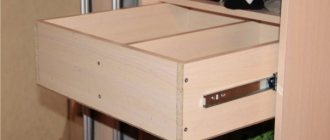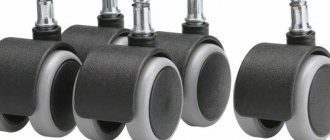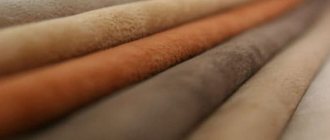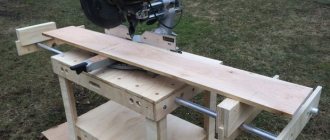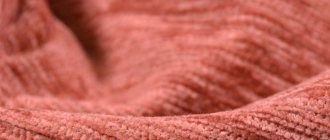What is sofa reupholstery?
Over time, upholstered furniture loses its aesthetic appearance and functional characteristics due to daily stress during use. Incidents happen especially often when there are small children and pets in the house. Updating a sofa may consist of various stages depending on the amount of damage:
- Upholstery fabric is replaced when the old one has stubborn stains, cuts, abrasions, or you want to update the interior without significant investment. This is the easiest repair option.
- Do-it-yourself furniture reupholstery may also include replacing the soft part if there are dented or deformed areas.
- Replacing the bottom of the frame or its other elements is rarely done, mainly for products that are of particular value to the owner. Such repairs will be comparable in cost to buying new furniture.
How much fabric is needed to reupholster a chair? Step-by-step instructions for reupholstering a chair with your own hands
Reupholstery of upholstered furniture begins with complete disassembly of the product and inspection of existing damage. Afterwards, the soft filler and fabric are measured, cut, and secured. The structure is assembled and decorated at your own discretion. Before starting work, it is recommended to read the instructions on how to disassemble and upholster the chair step by step.
Disassembly
Most old chairs are made of wood or from materials such as chipboard, and the fastenings are made on a tongue-and-groove basis, using steel corners, self-tapping screws, and wood glue. To disassemble the product, place it on its back, unscrew the legs and armrests. Next, disassemble the bottom, removing staples and other fasteners from it. Then the upholstery is removed as carefully as possible, which needs to be detached without damaging it, since it will be needed to cut out a new cover.
When disassembling, it is important to remember where everything was attached, otherwise there will be difficulties with assembly.
Assessment, damage correction
When the product is completely disassembled, all parts are disconnected, the fabric is removed, a thorough examination is carried out for cracks, chips, and joint defects. If such are found, they are dealt with first - broken parts are replaced with similar, homemade ones, loose connections are replaced. You also need to evaluate the condition of the padding - when the soft surface has serious unevenness, the material is torn or crumbles, it is removed, and a new one is nailed into the vacant space with staples. To make the edges look aesthetically pleasing, the corners of the foam rubber are cut off and something like a chamfer is made along the edge.
Cutting and attaching new fabric
The chair must be covered with properly cut material. Its quantity is calculated based on the perimeter of the back, seat, height of the filler, a few centimeters of hem on the back side of the structure. After measuring the product, a piece of fabric of the required size is selected. The standard fabric width is 140-150 cm, the length depends on the size of the chair, the height of the backrest, and the number of parts. If the structure is folding, a small allowance for unfolding is also necessary.
The standard set of elements is something like this:
- the front part of the backrest and seat are sometimes made in the form of a single piece;
- back surface of the back;
- armrests – internal, external parts;
- a narrow strip along the bottom;
- Some designs require the presence of side parts for armrests and backrest.
All fabric parts are pinned together, tried on a chair, and if necessary, the patterns are slightly adjusted. Next, the elements are sewn down on a sewing machine, the finished cover is put on the chair, pulled tightly, and secured with staples in inconspicuous places. If the work is done manually, use a “sail” or “denim” seam. If you have an overlocker, all seams are sewn over it - this will make the upholstery denser and prevent the joints from unraveling.
If fabric with pile is used, its direction on different parts of the structure must be monitored, since the multidirectionality is too visible in the light.
Assembly, decor of the updated product
The most difficult thing to assemble is a folding chair, since you will have to carefully fasten the moving mechanisms without losing the bolts or putting the part upside down. If the mechanism creaks or jams, lubricate it with machine oil. At the same stage, wooden parts are processed - they are sanded, tinted with stain, and varnished. The legs and wooden armrests are screwed in at the very end.
Pillows are most often used as decoration. They are sewn from the same fabric as the upholstery, made contrasting, decorated with embroidery and appliqué. If a product has many wooden parts, they are hand-painted and patinated.
What do you need to reupholster a sofa?
Before you start reupholstering the sofa, you need to decide on the scope of work and prepare all the necessary materials and tools. It is better to change only the upholstery and lining fabrics, the soft part made of foam rubber or padding polyester on your own. More global repairs should be entrusted to professional furniture makers. Covering a sofa with your own hands is possible only after careful preparation of all the necessary elements:
- upholstery fabric of suitable quality, size and color for the interior;
- lining fabric;
- edgings;
- felt, padding polyester or foam rubber as a soft filler;
- zippers;
- decorative buttons;
- the necessary tools and equipment.
Sofa upholstery material
One of the most important elements of repair is the correctly selected fabric for upholstering the sofa. When buying it, professionals advise:
- Choose practical and non-staining fabrics.
- Pay attention to natural materials without foreign odors and electrostatic properties.
- Do not buy cotton fabrics, as they wrinkle, quickly get dirty and fade.
- Keep in mind that large patterns and stripes require more material and more precise cutting.
The most optimal fabrics for upholstery are:
- chenille;
- tapestry;
- jacquard;
- synthetic vinyl;
- Genuine Leather;
- high-quality leatherette;
- microfiber;
- jeans
Tool for reupholstering a sofa
It is better to prepare tools, devices and components even before the start of repairs. It is worth considering that reupholstering a sofa with leather is a more important step than using simple fabrics due to the characteristics of the material. Regardless of the fabric chosen, you need to prepare:
- sewing machine;
- a set of needles, including marker ones;
- especially strong threads that match the color of the selected fabric;
- flat and figured screwdrivers;
- furniture stapler and anti-stapler;
- hammer;
- staples;
- pliers;
- spanners;
- scissors;
- sewing meter;
- long ruler;
- glue;
- chalk;
- drill and screwdriver.
How to take measurements for chair covers
The more accurate your measurements are, the more accurate your chair cover pattern will be. Particular attention should be paid to the legs, as they often widen towards the bottom, sometimes only the hind legs and only in one direction. Therefore, take as many measurements of the chair as possible and draw a diagram of your measurements before you begin constructing the slipcover pattern. Determine the widest areas and the narrowest and mark them on the drawing. Place the paper on the back and seat of the chair and trace their outline with a pencil. Then cut out these parts only not with tailor’s scissors, but with stationery scissors. Then fit the paper pattern exactly, applying it to the back and seat. Take the resulting patterns as a basis for constructing other parts of the cover pattern. These details will have to be done using calculations. All dimensions indicated on the drawing of the chair are relative and are given only as an example of what measurements should be taken.
Do-it-yourself sofa reupholstery
High-quality reupholstery of a sofa with your own hands is carried out step by step according to the following instructions:
- The first step is to disassemble the furniture. All constituent elements are completely separated from the base.
- Next, the old upholstery is carefully removed.
- The condition of the foam rubber is assessed. It is better to replace worn material with new one.
- If necessary, the spring block and frame are repaired and strengthened.
- New patterns are cut out and a cover is sewn.
- The sofa is covered with new fabric.
How to measure a sofa?
Before reupholstering a sofa, you need to measure it and accurately calculate the required amount of material. This can be done as follows:
- Add the length and width of the furniture along the back, multiplying the resulting amount by two. The product will be the required length of the fabric piece. This method is applicable for simple rectangular sofas.
- Often, reupholstering furniture at home involves repairing corner sofas. In this case, you can conditionally divide the ottoman into two parts and measure the parameters of each, multiplying by two, and then adding the resulting numbers.
- Thus, a standard sofa may require from 10 to 17 m of fabric.
- Fabrics with large patterns and stripes are cut in one direction. In addition, it is worth considering seam allowances, so a one-meter supply of material will never hurt.
How to disassemble a sofa?
Another method for determining the required amount of fabric for reupholstering a sofa at home is to measure all the parts of the old upholstery. To do this, you need to disassemble the furniture, carefully remove the old cover and measure all the parts along the same directions. The parsing procedure is carried out according to the following algorithm:
- All pillows, bolsters and decorative elements are removed.
- The back and sides are separated using a screwdriver or special fasteners.
- Reupholstering a corner sofa, in fact, like the standard model, necessarily includes storing all the fasteners in a separate special container.
- Old upholstery is almost always secured with furniture staples. They are removed with an anti-stapler or a flat-head screwdriver. In particularly difficult cases, you can use pliers.
- Then the old soft material is replaced and new upholstery is sewn.
How to correctly calculate fabric for covers
The first step when upholstering a sofa with your own hands is to calculate how many meters of fabric you need to purchase. For a standard piece of furniture you will need 8 square meters. m of material. If the product has an angular design or is made to individual sizes, you will have to arm yourself with a tape measure and start taking measurements.
The simplest method of performing measurements is implemented as follows:
- First, the width and length of the sofa are determined.
- Then the resulting values are multiplied by two, then it becomes clear what the dimensions of the required canvas should be.
You can independently measure the dimensions of the cladding fabric using the following method:
- Using a tape measure or tailor's yardstick, all elements of the sofa are measured.
- All components of the upholstery are schematically drawn on a sheet of paper with minimal waste and dimensions indicated.
- All data is summarized. Reserves for seams and cuts are taken into account.
- Based on the numbers obtained, the amount of fabric that will be needed to cover the sofa is determined.
How to choose upholstery fabric
Choose upholstery fabric with a density of 360 g/m². Pay attention to the pictograms on the inside:
- Chair - high strength fabric, suitable for furniture in public places.
- The chair has an average degree of wear resistance and is suitable for home upholstered furniture.
- Armchair and curtains - the fabric drapes well.
If the restored furniture is to be placed in a children's room, it is necessary to use only natural, hypoallergenic materials that are easy to clean: linen or cotton.
For furniture sets in the living room, choose synthetic fabrics that are easy to care for and durable. Flock, courtesan, artificial suede, microfiber will suit you.
Upholstered furniture on which people sleep should be upholstered in wear-resistant fabric with natural threads. Jacquard, chenille, tapestry, velor meet these requirements.
How to calculate the required amount of fabric
For an approximate calculation, multiply the sum of the length and width of a piece of furniture by 2. So, for a sofa with dimensions of 1.6 × 2 m you will need more than 7 linear meters of fabric.
This drawing will also help you determine the approximate yardage of upholstery fabric:
marrietta.ru
So, for a chair you will need from 2.7 m (for the simplest) to 7.5 m (for a chair-bed) or 8.2 m (for a chair with a pouf). For chairs you need 2–3 m of fabric, for poufs 2–5 m. For a sofa you will have to purchase from 2.7 m (compact simple) to 31 m (double corner).
Sewing covers is cheaper than completely reupholstering chairs
To sew a cover, it is enough to buy 1.5 - 2 meters of fabric and make the correct pattern, and sewing them yourself is not at all difficult. Fabrics for sewing chair covers can be used very inexpensively, the main thing is that they are easy to wash and iron. At the same time, they must be quite strong and dense, since the cover will be under constant stress, especially on chairs in the kitchen and dining room.
What tools are needed to reupholster furniture?
For basic restoration work you will need:
- Flat and Phillips screwdrivers.
- Furniture stapler.
- Stapler or pliers.
- Set of wrenches from 8 to 19 mm.
- Strong threads to reupholster the sofa with high quality.
- Scissors, wire cutters or side cutters.
- Decorative buttons.
- Glue or glue gun.
- Drill.
- Screwdriver.
To cut and sew new covers you will need:
- Sewing machine with high presser foot lift.
- Tailor's scissors.
- Crayons or thin pieces of soap.
- Threads - no less than No. 10 or reinforced for stiff fabrics.
- Meter ruler.
- Pattern paper (if you are going to modify the appearance of the product) or old covers.
To prevent the covers from slipping, they need to be secured to the legs of the chair.
When sewing covers, or rather, before cutting, think about how the covers will be attached to the chair. Even if the cover is worn in its entirety, almost to the floor, it will still “slide” while sitting and wrinkle. It is necessary to sew fastenings in the form of ties at the corners and tie them to the legs under the chair seat. If the back and seat are sewn separately, consider how they will be attached or tightened at the edge. The best option is to make a hem along the edge, where you insert an elastic band or cord that can be tightened and tied (take this hem into account when cutting). This will securely fix the cover on the seat or backrest, and it will not slip or wrinkle.
Reupholstering furniture: step-by-step instructions
Furniture repair consists of five stages:
- Disassembly, removal of individual elements (pillows, poufs and sides).
- Removing worn upholstery.
- Replacement of broken parts.
- Sewing and attaching new upholstery.
- Final assembly of the structure.
Let's consider all these stages using the example of a sofa.
Disassembly
Start by removing poufs, bolsters, pillows, drawers, folding tables, armrests, and removable pads. Using a screwdriver and keys, carefully remove the sides of the sofa, as well as the locks holding the back, drawer (bottom part) and seat.
To avoid misunderstandings during assembly, mark which parts should be on the right side of the sofa and which on the left. Be sure to take photos of each stage of dismantling.
During disassembly, place fasteners in a prepared container to ensure their safety.
strport.ru
Removing worn upholstery
Using a screwdriver and a furniture staple remover or pliers, remove the fastening brackets and old upholstery, which you will later use as patterns.
Please note: after removing the fabric, you need to remove all the filling to replace it with new one. Changing the stuffing will add elasticity to the sofa and remove lumps and dents formed during use.
pochinimmebel.ru
Replacing broken parts
After the sofa is disassembled, it is necessary to carefully examine its insides. Furniture fittings that have become unusable must be replaced. It’s worth saving on this only if you are confident that you can properly repair individual parts, such as folding or lifting mechanisms. This obviously does not apply to burst springs.
moyagostinaya.ru
The basis of the design of old sofas and armchairs is a wooden frame, the parts of which are fastened with locking saws and glue. Replace cracked beams with new ones made from dry, high-quality wood. Impregnate the joints of the frame with PVA before joining. Measure broken fiberboard parts and replace them with new ones by cutting them out with a jigsaw.
Attach the restored elements to the frame with nails or a pneumatic stapler. It is better to order the lock saw from a master carpenter.
After replacing the parts and the spring block, cover the updated frame with felt, secure the material around the perimeter with staples, and lay foam rubber on top.
Sewing and attaching new upholstery
Iron both upholstery fabrics well: old and new. Mark on the old upholstery which parts of the sofa it belongs to and separate them at the seams. Place the resulting parts on the new material, trace them with crayons or soap and transfer the marks to the wrong side of the fabric. When cutting, be sure to leave 3-4 cm for seams and fastenings.
Then cut out the parts of the new covers, finish the edges with an overlocker and sew. During the process, do fittings as often as possible.
Stages of work
Upholstering the product at home is not difficult. The whole process comes down to disassembly, fabric cutting, trimming and assembly. Even novice masters can do it in a day. Recommendations will simplify the process.
If the design of the chair is too complex, it is useful to watch the rules for disassembling the product in the video instructions.
Step-by-step instructions are a complete guide to action. Before starting work, you should read it to the end, then organize your tools. After completion of the work, the product can be decorated to your liking.
An assortment of cozy cocoon chairs, nuances of placing unusual furniture
Disassembling the product
Before upholstering an old chair, you need to disassemble it into separate parts. If you have no experience in assembling such models, it is recommended to record the process on paper or in the form of a photo report. Then there will be no problems with assembly at the final stage. Disassembly comes down to the following algorithm:
- dismantle all decorative elements;
- turn the product over, remove the legs;
- remove the fasteners, unscrew the screws and take out the nails;
- pull out old staples;
- remove the bottom.
Unscrew all parts of the structure gradually. The fabric is carefully removed so that it serves as a pattern for new upholstery. Self-upholstery can become part of restoration work. At this stage, you can replace rotten, damaged parts, and repair damaged areas.
A good filler can be left untouched, but a deformed one will have to be dismantled. Use a flat-head screwdriver to remove the staples and remove the foam. If it is glued, carefully cut it off in layers. All garbage and unusable material are sorted into bags so as not to litter the workspace.
Before continuing work, the product is cleaned of dust and damaged fittings are replaced. If necessary, cover the structure with protective compounds.
If you have to reupholster an office chair, the procedure does not change. Initially, all parts and decor are removed, the back and bottom are dismantled. Remove the upholstery and take out the filling. The only difference is in the design.
Cutting fabric
Replacing an old canvas with a new one involves preliminary cutting. You can transform the product with flock, jacquard, tapestry, leather, nubuck, chenille. The cutting method does not change depending on the type of material. A pattern can be created in two ways: tracing the old version, creating it from scratch by taking measurements. The first method eliminates the possibility of error. The process boils down to the following steps:
- Preparation. The old upholstery is ironed and laid out on a flat surface. For convenience, you can mark which part belongs to what.
- Open it up. Place the pieces on the new fabric, trace, and mark the hem allowance. It is advisable to overlock or hem the edges. This will extend the life of the upholstery. Cut out the details with tailor's scissors.
- Fitting. Place the parts on the chair, fold the edges for a hem, and check for correctness.
- Making adjustments. Cut off excess if necessary, add darts if the shape of the product is complex.
Types of gas lifts for office chairs, how the device works
You can also cut the foam rubber yourself to the shape of the old filler. Otherwise, the structural parts are cut to shape, leaving a few centimeters for fastening. An important condition is observed - upholstery fitting is carried out only on a structure with a filler.
Reupholstery and assembly
When all the decorative elements are updated, the parts are cut out, you can start reupholstering. Dust is removed from the structure and parts are prepared for assembly. Step-by-step instructions will tell you how to reupholster a chair with your own hands:
- foam rubber is applied and secured to the inside of the backrest;
- cut off the corners of the filler to make the corners smooth;
- apply batting and fix it with a stapler;
- stretch the materials so that there are no folds or distortions;
- apply the fabric and fasten it with a stapler;
- repeat the sequence of actions with the armrests and seat;
- attach the lower part and secure it.
Once the seats, armrests and backrest are reupholstered and the bottom panel is screwed down, you can put the updated decorative elements back in place. It is more difficult to work with the upholstery of leather chairs, since the leather has to be constantly stretched, preventing the formation of voids, folds, and distortion.
Reupholstering a chair is a simple step-by-step process that even a beginner can do. The main thing is to stock up on tools, choose the right fabric for upholstery and follow the instructions. It is useful to record all stages of disassembly so that there are no problems during assembly.
How much does it cost on average to reupholster a sofa with fabric?
Upholstering a sofa with fabric is a great way to update and give a modern look to a comfortable, but slightly time-worn, permanent fixture in every home. Professional upholstery replacement guarantees the perfect appearance of the furniture after restoration. The cost of reupholstery services in Russia varies from 2,500 to 20,000 rubles .
There is no need to rush into buying a new sofa if the upholstery replacement service is available. After assessing the condition of the sofa by specialists, you can begin choosing the material. In this case, you need to take into account the features of the selected fabric, cost and compliance with the overall design.
Types of sofas
The price of partial restoration (upholstery) primarily depends on the degree of wear, complexity of the model and type of sofa. Most common types:
Corner sofas are increasingly gaining popularity; they are convenient for simultaneously accommodating several people at once. They often have soft fabric armrests, which will also be taken into account when upholstering. The parameters of modular and island sofas are similar to corner sofas, in contrast to compact and economical double sofas.
replacement of the filling of soft parts is taken into account as necessary . A lot will depend on its quality - the service life of the upholstery with even load distribution, comfort, and presentability. Modern furniture manufacturers most often use PPU filler - polyurethane foam, or the classic version - spring sofas. An external inspection assessment will determine the need for this replacement.
First make test covers from inexpensive fabric
It is very difficult, without experience, to make an exact pattern for the covers, anyway, something will go wrong. There are so many models of chairs and options for their manufacture that it is simply impossible to give a ready-made pattern for sewing chair covers. The pattern for this or that shape and size of the chair is made differently, and the sewing technology may also differ.
To ensure that the cover fits tightly onto the chair, you can use long twisted zippers, discreetly inserting it into the side seam, but most often they use buttons and decorative ties at the back. You can come up with completely different ways to connect parts to each other, including the processing of seams. The back and seat can be cut separately, or you can do without a seam. The seams can be treated with overlock, zigzag and even bias tape, but they can be left untreated, especially if the fabric is not very loose.
For those who do not have experience, we can advise you to first sew a “test” cover from inexpensive fabric, for example from an old sheet, before cutting “expensive” fabric. Try it on several times, and make adjustments during the fitting process, sometimes even ripping out and sewing the “test” cover again. And only after you have achieved an exact copy of the shape of your chair, you can cut out the final version of the details of the covers.
Factors influencing prices
When replacing the upholstery of a sofa, you can do a full or partial reupholstery, in this case the price of repairs ranges from 2500-9000 rubles . Replacing the filler may also be incomplete; foam rubber or more technologically advanced and wear-resistant materials are used. In this case, the cost of services is estimated at 4,000-15,000 rubles . Urgency of the order is paid additionally, based on the percentage established by the studio.
When purchasing upholstery fabric, you can take the advice of experts or choose it yourself, focusing on your taste and preferences. velor , chenille , matting , tapestry or jacquard are usually chosen . The properties of these fabrics include resistance to mechanical damage, they retain their original appearance for a long time and look aesthetically pleasing.
Reupholstering a sofa at home and in the workshop
While many workshops offer a free visit of a specialist to inspect and take measurements, there is a service for restoring sofas at home. It is offered at the request of the client or if transporting the furniture is difficult. Working from home takes longer, this is probably the only difference, and the payment is calculated similarly to reupholstery in a workshop - the price of services plus the price of materials and the cost of additional costs. A paid call to a specialist for measurements costs from 300 rubles and more .
Sofa repairs are carried out in modern workshops or studios equipped with all tools and special equipment. You can find addresses on the Internet. Before making your choice, read reviews, view completed work, study prices and range of services. Do not rely on the advice of random people; choose a reliable service provider with many years of experience. It is important that the result of the work is no worse, and even a little better, than planned.
Let's summarize - the exact price for the service of upholstering a sofa with fabric will be calculated individually, taking into account all the characteristics of upholstered furniture and its dimensions. You can use materials and accessories suggested by experts or try to prove yourself as a designer by creating your own color and texture solution - the updated sofa will be unique.

